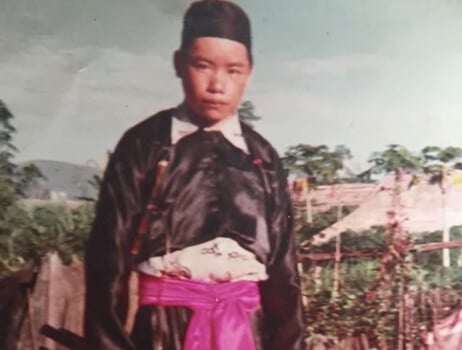
 A Minnesota PBS Initiative
A Minnesota PBS Initiative
Now, knowing how important the qeej is to my father, I want to learn how to play it and embrace it the way he does.
When I think about immigration, I think of my own family. We migrated from Wat Tham Krabok refugee camp in Saraburi, Thailand to Saint Paul, Minnesota on September 16, 2004. I can still remember carrying whatever we can on our backs and putting large items in suit cases.
I can still remember my dad carefully wrapping his qeej with black cloth and carrying it with him, all the way to the United States. At this time, I even wondered why did he even bother bringing this instrument?

This is my father. His name is Vang Thao. He was born in Vang Vieng, Laos in 1955. He migrated with his family to Vientiane, Laos in 1979 where he got married. In 1993, his family migrated to Wat Tham Krabok refugee camp in Saraburi, Thailand, where my younger siblings and I was born and raised. Wat Tham Krabok refugee camp was home to my family until we came to the United States in 2004 in hope for a better life.
As the oldest of four children, my father stayed home instead of going to school. He helped around the house and on the farm. While he worked, his younger siblings went to school. At the age of five, he started learning the qeej from his dad. At the age of 30, he was able to get his own qeej for 3,000 baht, equivalent to 90 U.S. Dollars. As he was growing up, whoever was educated or knew how to play one of Hmong many instruments was highly respected. As a qeej player, he gained respect from his parents and his community even though he was not educated as a young boy. The qeej is an important Hmong reed instrument.
Today it is still being played at funerals to pay tributes to the dead. Also it is played at the Hmong New Year to celebrate the upcoming year. There are two parts when it comes to playing the qeej. There is the spoken part or the translation part and then there is the actual musical part. This is what makes learning the qeej so difficult. You have to learn both parts in order to play it.
Traditionally, the qeej was meant for males only, but as time changed, anyone who wishes to learn how to play the qeej can learn it. Playing the qeej, it allows my dad to embrace his culture and traditions. It is a way for him to remember who he is and where he came from.
Now, my father’s qeej sit in the basement still covered in the same black cloth. I’ve seen him take it out to play once in a while. He used it to play at funerals numerous times. Even though its importance has changed over time, the qeej is still pride and honor to my father. This is proven by the smile on his face every time he talks about his qeej. Now I know why he took his time wrapping this unique instrument of his, taking it half way around the globe. It is because the qeej reminds him of his hometown and who he is as a person.
I choose to talk about my father’s qeej because he carefully carried it with him all the way from the refugee camp to the United States. On our way to the United States, I can still remember my mom holding our holds while my dad held tight on to his qeej. As a young girl, I tried to learn how to play the qeej but I gave up after finding out how hard it was to learn the instrument. Now, knowing how important the qeej is to my father, I want to learn how to play it and embrace it the way he does.

Immigrant Stories invites immigrants, refugees, and their families to create digital stories about their experiences. Each story is preserved in the Immigration History Research Center & Archives at the University of Minnesota, where they have collected materials related to immigration in the U.S. since 1965.
Story Themes: Family, Hmong, Immigrant Stories, Laos, Music, queej, Refugee, Refugee Camp, Thailand, Wat Tham Krabok